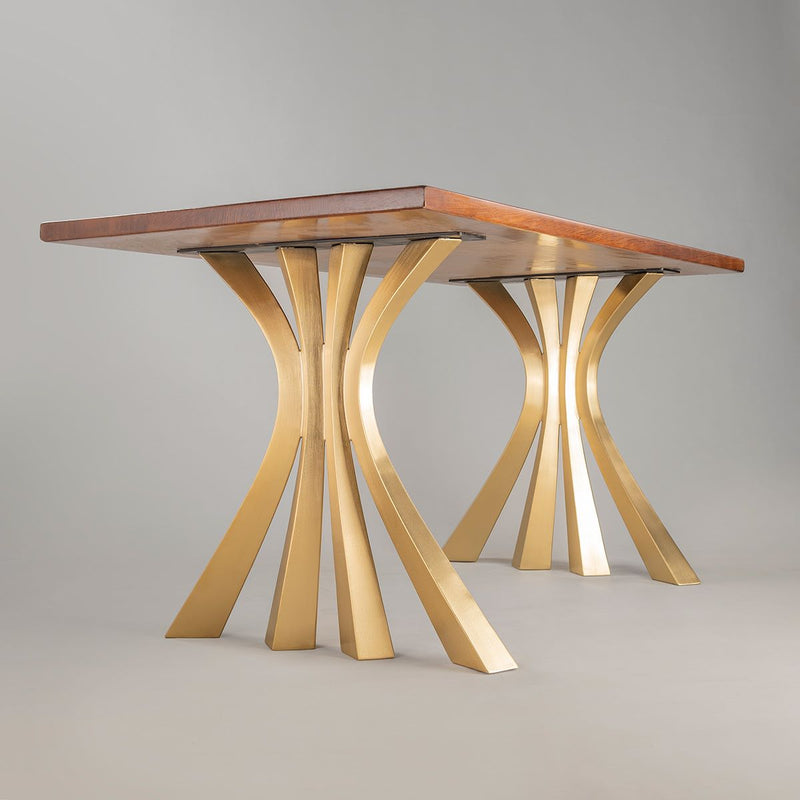A Detailed Appearance at Dining Table Leg Styles: Locating the Perfect Match
Picking the appropriate dining table leg design is critical for both aesthetic allure and useful performance. For those with larger tables, trestle legs ensure durable support, whereas hairpin legs introduce a mid-century contemporary ambiance with their minimal design. The x-shaped legs mix modern design with improved security.
Typical 4 Legs
Among the different kinds of table leg styles, the traditional four-leg design remains a timeless choice for several homes. This classic setup supplies a harmonious blend of performance and aesthetic appeals, making it a perennial favorite. 4 legs give well balanced assistance, ensuring the table remains stable and with the ability of birthing considerable weight. This is particularly beneficial for households that often organize huge gatherings or use their eating table for multiple functions, such as job or crafting.
From an aesthetic viewpoint, the conventional four-leg design can be easily adjusted to numerous indoor styles. Whether crafted from wood, steel, or a mix of materials, these legs can be elaborately sculpted, smooth and minimalistic, or anything in between. Their adaptability allows them to match both rustic and contemporary setups perfectly.
Moreover, the straightforward structure of the four-leg style facilitates convenience of activity and placement within a space. Unlike more complicated bases, this design decreases blockages, supplying enough legroom for restaurants. In summary, the conventional four-leg eating table leg design weds sustaining beauty with practical capability, making it a sharp option for those seeking both type and function in their dining furniture.
Pedestal Base
Usually commemorated for its elegant and space-efficient layout, the pedestal base is a prominent choice to the traditional four-leg arrangement in dining table leg designs. This distinct base commonly includes a solitary main column sustaining the tabletop, which can vary in form, from ornately carved wood to sleek, modern metal. Among the primary benefits of the pedestal base is its capability to maximize legroom and seating adaptability. Without edge legs, restaurants are afforded higher flexibility of motion, making it an excellent choice for round and oblong tables that advertise even more intimate and inclusive events.
Moreover, the stand base's main support can manage substantial weight, permitting making use of much heavier tabletops, such as marble or thick wood. This stamina coupled with its aesthetic versatility makes the stand base a popular option in both typical and contemporary indoor settings. It can perfectly integrate with numerous design motifs, from classic sophistication to minimalist modernity. Furthermore, the central column itself supplies a canvas for complex designs and creative expressions, adding a component of aesthetic interest below the table. In summary, the pedestal base incorporates functionality with style, making it an improved and functional option for diverse eating atmospheres.
Trestle Legs
Trestle legs provide a durable and classic foundation for dining tables, defined by their straight cross-bracing and tough support beams. Stemming from medieval times, this style has evolved yet retained its vital framework, making it a perennial fave in both typical and contemporary setups. The main trestle beam of light, typically supported by 2 or even more vertical articles, uses remarkable security, enabling bigger table sizes without the demand for additional legs.
A considerable benefit of trestle leg tables is the sufficient legroom they use. Unlike tables with 4 corner legs, the absence of obstructions at the table's edges provides unobstructed room for chairs and restaurants, enhancing comfort and access. This makes trestle tables perfect for suiting bigger gatherings, whether in an eating space or a reception hall.
The visual adaptability of trestle legs is notable. Available in a range of products such as timber, metal, and composite, they can be ended up to enhance a wide variety of interior styles. From rustic farmhouse to sleek contemporary styles, trestle legs can be customized to fit private tastes. Their enduring allure and useful benefits make trestle legs an engaging choice for those seeking both style and functionality in their eating table.
Hairpin Legs

The appeal of barrette legs hinges on their simpleness and convenience - dining room table legs. Available in a series of materials, consisting of steel and brass, they can be finished in numerous colors to match different indoor designs. Whether paired with a rustic wood tabletop or a modern glass surface, barrette legs easily mix performance with a touch of vintage appeal
Durability is an additional notable attribute of barrette legs. Regardless of their delicate appearance, these legs are crafted to birth significant weight, ensuring the eating table stays stable and secure. Furthermore, they are reasonably very easy to mount, making them a preferred option for do it yourself fanatics and professional furnishings makers alike.
X-Shaped Legs

Created from materials such as steel, timber, or a combination of both, X-shaped legs can be customized to More Bonuses match numerous design choices. Steel legs commonly provide a streamlined and industrial feeling, ideal for loft-style homes and modern dining areas. On the various other hand, wood X-shaped legs supply a warmer, more rustic charm, ideal for farmhouse or diverse insides. The versatility in materials enables home owners to personalize their table to much better fit their total style system.
In addition, the engineering behind X-shaped legs guarantees even weight distribution, lessening the danger of wobbling and improving durability. This makes them specifically well-suited for larger dining tables that call for additional assistance. In essence, X-shaped legs blend sensible design with contemporary aesthetics, making them an ageless option for diverse eating atmospheres.
Final Thought
A comprehensive understanding of table leg designs reveals the distinct attributes and advantages of each style. Standard four legs provide stability and ageless appeal, while pedestal bases provide legroom important link and a structured appearance. Trestle legs make certain robust assistance for bigger tables, and barrette legs present a mid-century contemporary aesthetic. X-shaped legs integrate contemporary layout with improved stability. Choosing the proper leg style ensures both useful and aesthetic contentment in any type of dining room.
Comments on “One-of-a-kind Dining Room Table Legs to Change Your Eating Area”